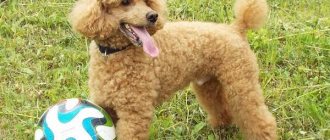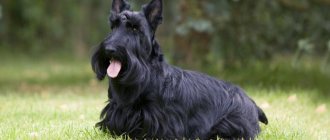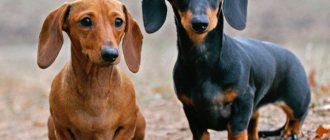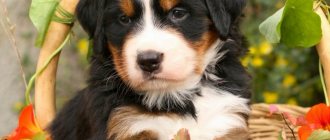From the history of the appearance of the breed
The smallest poodle was bred from a large poodle, which is considered standard and is not a decorative breed, but a service and sporting breed. Unlike the royal and medium, the toy poodle is a young breed that appeared only in the 20th century. The main goals of selection when breeding it were to reduce its size as much as possible and give it a particularly decorative appearance, so that the dog would resemble a charming toy. The latest FCI standard for the breed was registered in 2007.
By the way! There is a legend that the toy poodle was brought by sailors from Asian countries, but there is no official confirmation of this.
History of the breed
The first mention of a similar dog was recorded on ancient coins, on bas-reliefs, in Roman tombs dating back to the 30s. BC. Images on the walls of monasteries and paintings appeared in the 12th century. By the 16th century it gained popularity. National representative of France. The French developed different species for different purposes. Large, hunting breeds, dwarf dogs were always with the ladies. The middle ones “hunted” for truffles. Standards for French pets were set much later - in the 19th century. For hunting, white was preferable to black. In the forest, a white dog is easier to see.
The Miniature Poodle is an ideal breed for keeping at home. History is silent about how the dwarf-sized poodle dog was bred. From the point of view of experts, it appeared during the fashion for “pocket” dogs. Fashion is inexorable, and after the dwarf breeds came the toy poodles. The small size of these pets does not interfere with their natural characteristics. A keen sense of smell, flexibility and mobility are all the basic instincts of a hunter. And breeders have always paid attention to these aspects.
No matter how scientists and breeders experimented with developing new varieties of poodles, the unique appearance remained intact. This is a small copy of its tall predecessor. Balanced proportions indicate good survival of the dog. Weight - from four to six kilograms. The color is even, without any splashes of another color. According to the standards, there are five colors: black, white, apricot, silver and brown. Typically, over the course of life, from puppy to adult, there is likely to be a change in shade, but not the color itself. Black doesn't change.
Description of the breed with photos
The prefix toy in the name means “toy” in English. Representatives of the breed outwardly correspond to this characteristic. The toy poodle has a proportional build, a joyful facial expression and a cheerful disposition. Sometimes the toy is called the small poodle .
- Head. The shape is correct according to the fox type. The forehead is convex, slightly oblong, of medium width. The eye arches are well developed, but do not give the muzzle a heavy appearance. The bridge of the nose is shorter than the forehead, straight. The jaws are quite strong with a full set of white teeth. Scissor bite.
- Nose. The size is proportional to the head. It looks flat from above, with a rectangular profile. The color of the lobe is black or matches the color of the coat.
- Eyes. Almond shaped. The eyelids are dense and colored. The color of the iris ranges from dark brown to golden amber. The look is interested, expressive.
- Ears. Hanging, close to the head. Rectangular shape with rounded ends. If the dog is interested in something, he lifts them slightly and turns them forward a little.
- Body. The poodle's build is correct, without unnecessary elongation. The scruff is pronounced. The withers are smoothed. The back is of medium width, tapering at the croup. The loin is pronounced. The croup is rounded. The transition line to the hip is smooth. The chest is oval in shape. The ribs are wide and springy. The front part of the sternum protrudes slightly beyond the front paws. The chest is lowered to the level of the elbow joints. The belly is tucked up, which gives the animal a sporty appearance.
- Tail. Set high, without bending. The breed standard allows for natural length or docking.
- Paws. Smooth, proportional to the body in length, with strong joints. Hips with pronounced smooth muscles, wide. The paw is collected tightly. There are small connecting membranes between the fingers. The toe pads and claws should be nose-colored or black.
Minor deviations in the appearance of a poodle from the standards are not a reason for culling, but will reduce the exhibition score. Dogs with severe defects are not allowed for exhibitions and are not recommended for breeding.
Size and weight
The weight and height of an adult dog depends on the category - toy or small toy . The first has a height at the withers of up to 28 cm , and the second does not exceed 25 cm . Poodles whose size at the withers exceeds 28 cm are classified as dwarf. The weight of the toy is from 3 to 5 kg . A small one weighs no more than 2 kg .
Coat type
The poodle's coat is curly, abundant, with fine guard hairs. It is elastic and resists compression. Less common are individuals with coarse corded hair, which is also allowed by the standard. The dog has no undercoat, as well as a dog smell. Poodles do not actively shed. They are hypoallergenic breeds.
Variety of colors
Toy poodle coat colors vary. The official breed standards have approved 6 options. Crossing dogs with different coat colors can produce puppies of unpredictable mixed colors. They are not suitable for exhibitions, but, due to their decorative nature, are very popular.
- White. Common and one of the most popular colors. This dog looks like a toy. The puppy may have a slight apricot or cream tint to the coat, which fades as it matures. A white dog's skin is pink or spotted. The nose and claws are black. The eyes are brown.
- Black. Refers to the classics. The wool should not have gray, brown, silver shades or a reddish tint. The nose, paw pads and claws are only black, without spots. Skin blue or gray.
- Chocolate (brown). The coat color is a uniform rich brown color. On the ears, the fur is slightly lighter than the base tone. The nose is brown. Eyes brown or amber.
- Silver. The coat is a smooth gray color. The adult coloration develops during the first 2-3 years of a dog's life. At birth, puppies are black. The silver color can be determined starting at 6 weeks. Nose, lips, eyelids black. Eye color is dark brown.
- Red. The main shade is mahogany (dark red). The color of the nose, eyelids and lips is brown or black.
- Apricot. Any apricot shades are acceptable. As the dog ages, it becomes lighter in color. Quite often, old dogs turn from apricot to cream. Skin color is pink, less often blue. The color of the eyelids and nose is brown or black.
Since 2007, two more color varieties have been recognized as the standard - white and black harlequin and black and tan. The second is a black poodle with small markings of any color.
Description of the breed
FCI Standard No. 172 dated January 23, 2015 “Toy Poodle”. Group 9 “Indoor decorative dogs and companions.” Section 2 “Poodles”.
The dimensions of an adult toy poodle are 24-28 cm in height at the withers (ideal height is 25 cm), weight no more than 3 kg.
The dwarf variety is slightly larger in size. Toy Poodle and Miniature Poodle: What's the Difference?
The Cynological Federation does not recognize any differences between them, with the exception of the height at the withers.
The dwarf poodle is taller: from 28 cm to 35 cm. The toy generally retains all the main qualities of the dwarf poodle, with the same proportions, meeting all the requirements of the standard. All signs of dwarf dwarfism (abnormal short stature) are excluded, only the occipital protuberance may be less pronounced.
Exterior standard
The official conformation standard contains the following characteristics of the Toy Poodle breed:
- Head. An elongated “fox” muzzle, smoothly descending from a narrow forehead covered with fur. Large dark nose and narrow-set dark, almost black almond-shaped eyes (interspersed with amber highlights in apricot-colored dogs).
- Ears. Strongly widening towards the bottom and rounded at the ends, hanging, flat. Completely covered with long hair in soft curls.
- Tail. They are docked in the nursery at an early age, although natural length is allowed.
- Color. Any solid color is acceptable, but clear shades are preferred.
- Addition. Proportional body, strong straight legs with well-developed muscles, good posture with a high, graceful head. The paws are small, gathered into a ball, with neat pads.
The photo of an adult toy poodle clearly shows the exterior features.
Health and illness
Small breed dogs often suffer from diseases. The toy poodle is most susceptible to several pathologies.
- Fusion of the nasal passages. The defect is congenital. The dog has severe snoring and difficulty breathing. Treatment is surgical.
- Pathologies of the cardiovascular system. To reduce the risk of disease, your pet should be protected from stress and not subjected to physical exertion.
- Eye diseases. The most common group of diseases found in poodles of various varieties. Most often, dogs are diagnosed with conjunctivitis, cataracts, glaucoma, retinal atrophy, and entropion. Almost all diseases have a genetic predisposition, and their treatment is of little effectiveness. It is not uncommon for older poodles to have poor vision or become completely blind.
- Epilepsy. It is usually diagnosed in puppies and can either progress or go into a state of stable remission throughout life. The pathology is hereditary in nature, which is mainly associated with the high nervous excitability of the animal.
- Diabetes. The pancreas of all toy dogs is quite weak. Genetic predisposition plays the main role here. Eating disorders significantly increase the risk of developing the disease. Supportive therapy was adopted.
- Diseases of the mouth. Toy poodles often suffer from gingivitis and ulcerative stomatitis as they age. The main causes of these diseases are poor nutrition and insufficient oral care. Regular tartar removal, a balanced diet and preventative visits to the veterinarian will help avoid problems.
- Otitis. The disease is mainly related to the shape of the ears. Long and hanging, they do not allow the internal funnels to be fully ventilated, and if water gets into them, they prevent it from flowing out. The dog easily develops inflammation (purulent or non-purulent). The main preventative measure against otitis media is proper ear hygiene.
- Urolithiasis disease. Metabolic disorders are common to all dwarf dogs. They cause the accumulation of salts and improper removal from the body, causing the appearance of stones in the kidneys, ureter and bladder.
Small breeds are highly susceptible to viral pathologies, which is why strict adherence to the vaccination schedule and the quarantine period after them is necessary. During the first 12 months of life, the puppy receives 3 vaccinations, then vaccinations are given once every year.
Lifespan
Despite its delicate health, the small poodle is a long-lived dog. If the owner follows all recommendations for keeping and feeding the pet, it can live up to 16 years. It is not uncommon for a dog, if it has not suffered from viral infections, to live for 18 years. To maintain health, older poodles require a more fortified diet, and they also need to visit the veterinarian regularly (at least once every 3 months).
Upbringing
Education begins at three months of age. He likes to fuss, get in the way and bark a lot. The sooner you teach her manners, the less trouble she will give you in the future. They quickly get used to commands and quite complex tricks. Training is only a pleasure for the poodle. For a piece of treat and praise, he does everything that the owner requires. Never physically punish, it is enough to look dissatisfied. This smart creature will understand everything. All education is based on play, fun without pressure. The breed is proud and aristocratic. It is not for nothing that this representative at one time was a favorite of the kings themselves, poets, and aristocratic nobility. The main thing is to train correctly and consistently so that the black poodle understands the requirements. And patience.
Always remember - a poodle is a decorative dog and you should not give it tasks that it cannot complete. She will never be a guard dog. Will not strike first. The biggest thing is that it can bark and warn about a stranger.
General characteristics of the dog:
- Height: Large: 45-60 cm, Medium: 35-45 cm, Miniature: 28-35 cm, Miniature Poodle, Breed Description: Less than 28 cm, preferably 25 cm.
- The weight of an adult is up to 30 kg.
- On average, they live 10–12 years; miniature and dwarf ones can live up to 17 years.
- Coat color: blonde, brunette, red, brown-haired, silver, apricot.
The breed varieties differ only in height:
- Large (royal) poodle. The very first breed. Magnificent hunters. A very strong and resilient dog.
- Toy poodle, breed description: compact dog for the home.
- Miniature poodle, description of the breed: everyone is accustomed to considering the poodle a female, tame dog.
Toy poodle, breed description:
- intellectual, distinguished by mental alertness;
- easy to train, flexible to train;
- kind, balanced disposition;
- great for home keeping;
- mostly not aggressive;
- they make contact easily and are not afraid of children;
- undemanding in care;
- expressive appearance.
Negative rating:
- a lot of attention should be given;
- increased activity;
- systematic haircut to maintain shape.
Character and intelligence
All poodles are highly intelligent, easy to train and can master complex tricks with interest. When living in a family, the dog quickly remembers the basic phrases of those around him and begins to understand not only commands, but also speech addressed to him.
Toy poodles have a cheerful and active character. They become very attached to their owners and require a lot of attention. These dogs do not tolerate loneliness well, which is why they cannot remain alone in an apartment for a long time without damaging their psyche. If your toy poodle is forced to be alone during the day, you should have a second pet (dog or cat) with whom he can communicate. Otherwise, you cannot have this breed.
Attitude towards children and others
Poodles willingly take part in children's games, but only if this does not cause them any unpleasant sensations. When children try to force a dog to communicate, it may display its hunting nature and use its teeth. Because of this, adults should explain to the child that the poodle is not a toy, but a full member of the family that should be taken into account.
The toy poodle behaves friendly with other pets and quickly finds a common language with them. He will willingly communicate not only with dogs close in size to him, but also with large ones, as well as cats.
The Toy Poodle is friendly towards strangers. He will willingly play with guests if they want it, but he will not impose himself. The pet is indifferent to passers-by on the streets: he does not try to get to know them and does not show aggression.
Training and education
Due to their high natural intelligence, poodles quickly learn commands, and there are no difficulties with their upbringing and training. It is recommended to train the puppy in a playful way with classes lasting no more than 15 minutes. You can repeat lessons only several times a day. The dog's nervous system is highly sensitive, and it is unacceptable to apply harsh training and punishment to it. For each action performed, the pet should be rewarded with a treat.
First of all, your pet needs to be trained to follow the commands “come” and “fu”, as they are necessary during walks.
Important! Animals that are being prepared for exhibitions must be taught from an early age to behave calmly when examining their teeth, as well as to walk and stand correctly.
Some owners are of the opinion that a toy poodle dog does not need training. This belief is erroneous, since during a walk a pet can pick up and eat something harmful, and if it gets carried away with its own business, it may not immediately return to its owner and get lost. Also, lack of education leads to problems when traveling and when visiting the veterinarian.
Breed standard (appearance)
Pomsky (dog): description of the breed, character
The toy poodle looks like a toy dog; it is not for nothing that the breed got its name from the English “toy”, which translates as “toy”. The dimensions are amazing: the weight of an adult toy poodle does not exceed 2.5 kg, and the height at the withers is no more than 28 cm.
According to the FCI standard, poodles are distinguished by the following characteristics:
- by height - 4 varieties: large or royal, small, dwarf and toy poodles;
- color - 6: toy poodle white, black, brown or chocolate, silver or gray, apricot (red poodle) and red;
- Coat type: 2: curly and corded.
Toy poodle - the description of the breed looks like this:
- The head is elongated and looks like a fox. The narrow forehead protrudes slightly forward. The transition from forehead to nose is smooth. Cheeks and cheekbones are almost flat.
- The ears, rounded at the edges, hang down and widen towards the bottom. The muzzle does not look heavy due to the slightly prominent eyebrows.
- The nose is small with a large nose (black or brown). A light nose is a deviation from the norm (acceptable only in harlequins).
- A harmoniously built body with a head set high, which is why the posture is proud and arrogant.
- The paws are strong and stable. The tail is docked in puppyhood.
Show mini poodle
Eye and nose color
Almond-shaped eyes can be dark brown or light amber if the dogs have the following colors:
- brown (chocolate);
- apricot;
- close to red.
The nose can be:
- dark - in a black toy poodle and a white one;
- brown - for chocolate, apricot and red;
- black - in a silver mini toy poodle.
Note! Harlequins' noses should be the same color as the spots on their coat.
Pros and cons of the breed
| Toy poodle - advantages of the breed | Toy poodle - disadvantages of the breed |
| Hypoallergenic | Increased need for attention |
| Cheerful character | Very high activity |
| High intelligence | Need to take long walks daily |
| Possibility of keeping different animals | Need for daily brushing |
| High life expectancy | Intolerance of loneliness |
| Beautiful appearance | Tendency to many diseases |
| Variety of colors |
When deciding whether to adopt a toy poodle, you should very carefully evaluate all the pros and cons of the breed, the traits and character traits of the animal that are significant in a particular case.
Care and maintenance
You can only keep a miniature poodle in an apartment. The possibility of free walking in the garden will help improve the health of the dog. Just because your pet can be litter box trained, like most toy breeds, doesn't mean it won't require walking. Every day the dog needs to be walked 2 times a day. The duration of the walk cannot be less than 1 hour.
Even a dog with a haircut should be combed once a day. They bathe the small poodle using a special shampoo for animals once every month and a half. Examination of teeth and oral cavity is carried out once a week. If damage is detected, a visit to the veterinarian is required. Nails are trimmed regularly as needed. Once a week, wipe the animal’s eyes and ears with a cotton swab. For the eyes it is soaked in calendula balm, and for the ears in antiseptic. You need to use a different swab for each ear and each eye. If purulent discharge is detected, you must immediately visit a veterinary clinic.
From the first day of life, a small poodle in the house should have its own bed, toys and dishes. For walks in rainy, damp weather, it is better to stock up on overalls.
Important! If the owner decides to take the pet to bed, then even after the first time it will be impossible to wean the poodle from sleeping together. When you don’t want to let your dog into bed all the time, you shouldn’t do it just once.
What to feed your pet
When a miniature poodle is prone to allergies, ready-made hypoallergenic food is chosen for feeding it. In other cases, natural nutrition is preferable. It should be balanced, varied and always fresh. The water in the drinking bowl must always be unboiled and clean. It should be changed at least 2 times a day. The volume of the drinking bowl needs to be at least 500 ml.
The dog's diet should consist of ½ lean meat. It is pre-scalded, and for older dogs it is boiled. You also need cereals, mainly buckwheat, rice and oatmeal, cooked in water and seasoned with vegetable oil. Lean sea fish is given only boiled and no more than 2 times a week.
Vegetables, with the exception of potatoes and legumes, fresh or steamed are required daily. Fruits are given only as a treat and are not very sweet. Egg yolk (preferably from quail eggs) is included in the diet 2 times a week in small quantities. If the dog is intolerant of fermented milk products, cottage cheese, kefir or fermented baked milk are given to the dog no more than 2 times a week. Feeding frequency for puppies and adult poodles is the same as for other breeds.
Important! It is strictly forbidden to give your pet sweets, flour, fatty foods, as well as fried, smoked and salty foods.
How to choose a puppy
When choosing a toy poodle puppy, you should carefully study the documents of its parents, ideally if they can be seen, and also examine the animal. Healthy puppies are active, have clean eyes and noses, and no traces of feces in the anal area. The puppy's fur should not be matted. Infection with fleas or worms indicates an unscrupulous breeder. The abdomen should be firm, but not bloated. Its excessive size indicates intestinal diseases or severe clay infestations. It is highly undesirable to purchase such a pet.
The Toy Poodle breed is one of the popular decorative dog breeds. Such pets, even at an advanced age, are characterized by optimism and cheerfulness. They are equally suitable for a family with children and a single person. Proper care and proper feeding will maximize the life of a miniature dog.
Some tips if you decide to buy a poodle
Do you just need a dog with a lively temperament, playful and cheerful, just a friend and companion? In this case, feel free to go to the market and choose any puppy you like. The average price is about 10 thousand rubles.
Do you want to take your pet to exhibitions and shows? To receive awards and participate in any events, then you only need to go to the nursery. At four months, all the signs of whether the dog will be popular are visible. Pay attention to your health, when your vaccinations were done, and the condition of your ears and eyes.











